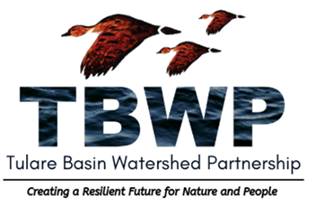Tulare Basin Regional Conservation Reports
To address current and potential land and water management challenges, the Tulare Basin Working Group, an alliance of over 70 non-profit, agency, and industry partners, directed Tulare Basin Wildlife Partners (TBWP) to develop a comprehensive conservation plan for the Tulare Basin, built on, updating, and expanding existing conservation plans. In 2010, TBWP completed the Tulare Basin Regional Conservation Report, which identifies important lands to protect or restore: seasonal and permanent wetlands, riparian areas, and upland habitat, benefiting wildlife and people in the Tulare Basin. The conservation lands would be managed by federal agencies, states, tribes, cities, non-profit organizations, and private landowners. The majority of the lands would remain as privately-owned, working landscapes.
The Tulare Basin Regional Conservation Report is divided into five parts: The first three volumes each examine a different area within the Tulare Basin: Goose Lake Conservation Report (April 2006), the Sand Ridge-Tulare Lake Conservation Report (July 2006), the Buena Vista Lake-Kern Lake Conservation Report (December 2006). Together, these plans would protect or restore over 100,000 acres of wetlands, including approximately 6,668 acres of permanent wetlands– increasing the current amount of permanent wetlands by 97%. These plans also identify 292,000 acres of upland habitat for protection and restoration.
A fourth volume, the Tulare Basin Riparian and Wildlife Corridor Conservation Report (February 2009), identifies 16 key corridors connecting conservation areas and surrounding landscapes. The predicted changes in climate and precipitation patterns will have a profound impact on the physical, ecological, and agricultural characteristics of the Tulare Basin. The linkages identified in the Corridor Plan are a key element in the climate change adaptation strategy for the Tulare Basin. Corridors linking larger protected areas to each other and to the surrounding mountain ranges will enable Tulare Basin flora and fauna to migrate to different latitudes or higher elevations as climate change makes their current homes inhospitable. The Tulare Basin Riparian and Wildlife Corridor Conservation Plan would protect or restore approximately 30,000 acres of riparian habitat and 550,000 acres of upland habitat.
Click here to read the Tulare Basin Wetland and Riparian Water Supply Needs.A fifth and final volume, Tulare Basin Regional Conservation Plan Water Supply Strategies Report (March 2010) complements the other four plans. Sufficient water is critical to the management and restoration of wetland and riparian habitats in the Tulare Basin. The Water Supply Strategies Report quantifies the water needs for the four area plans described above and identifies potential water supplies. The report concludes that the total environmental water demand is between approximately 540,000 – 366,000 acre feet annually. The former figure applies to very wet years and assumes maximum utilization of all existing and potential wetland and riparian habitat; the latter figure is a dry year minimum required to maintain permanent wetlands and water-dependent riparian vegetation. This uniquely valuable report sets the stage for Tulare Basin water agencies and the TBWP to partner, collaboratively plan, and implement conservation and water management improvement projects on the local and regional level. It prioritizes leading opportunities to protect, restore, and enhance habitat at the watershed and landscape scale.
The Tulare Basin Regional Conservation Report calls for impressive landscape-scale conservation measures that will protect and restore uplands and wetlands in this important place. These plans share common land and water management goals for each planning area in the Tulare Basin:
- Conserve existing upland habitat, such as grassland and shrubland, and travel corridors between these areas for threatened and endangered wildlife species.
- Create or restore wildlife corridors that have been lost between existing patches of grassland and shrubland.
- Protect and restore floodplains, marshes, and open water for wintering, migratory, and nesting waterfowl.
- Provide breeding season wetland habitat for waterfowl, shorebirds, colonial water birds, and other unique wildlife species, including Buena Vista Lake shrew (Sorex ornatus relictus), giant garter snake (Thamnophis gigas), California red-legged frog (Rana aurora draytonii), southwestern pond turtle (Emmys marmorata pallida), fulvous whistling-duck (Dendrocygna bicolor), and least bittern (Ixobrychus exilis).
- Restore critical wildlife habitats such as saltbush scrub, alkali sink, valley grassland, wetlands, and riparian areas along creeks and streams.
- Provide flood control benefits for cities, farms, and wildlife habitat by protecting or creating wetlands to store flood water.
- Recreate integrated historical southern San Joaquin Valley landscapes.
TBWP produced the Tulare Basin Regional Conservation Report in collaboration with the California Department of Fish and Game, U.S. Bureau of Reclamation, USDA Natural Resources Conservation Service and the Tulare Basin Working Group participants. Conservation tools such as these provide a roadmap for agencies, elected officials, landowners and agricultural associations to make informed decisions about land and water challenges in the Tulare Basin.
Implementing these landscape-scale solutions to land and water management challenges requires collaboration between a wide diversity of residents and partners. By working together, we can protect wildlife-friendly farms, land for livestock grazing, significant wetlands, and wildlife travel corridors, while providing recreation and education opportunities and places to inspire the soul.
